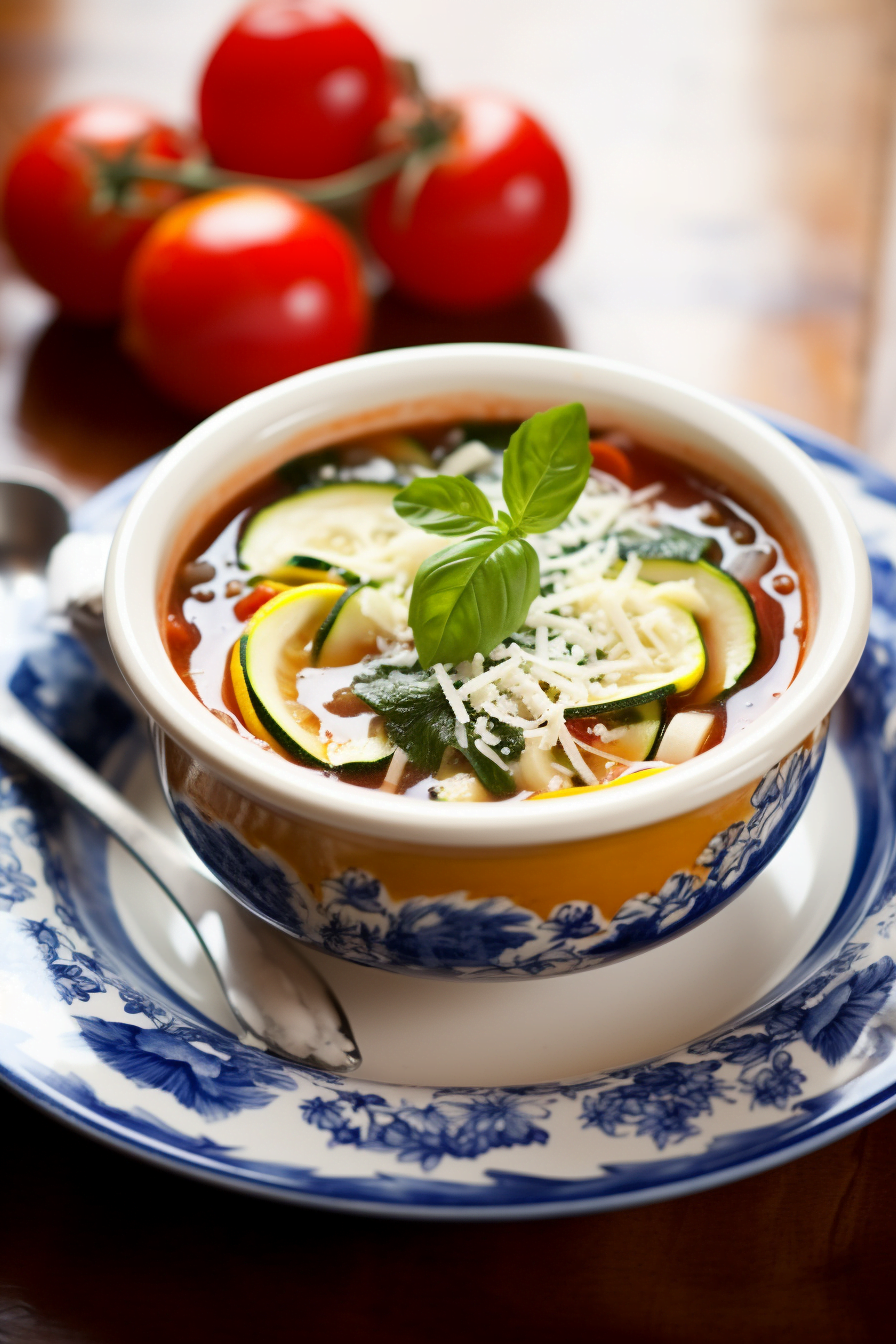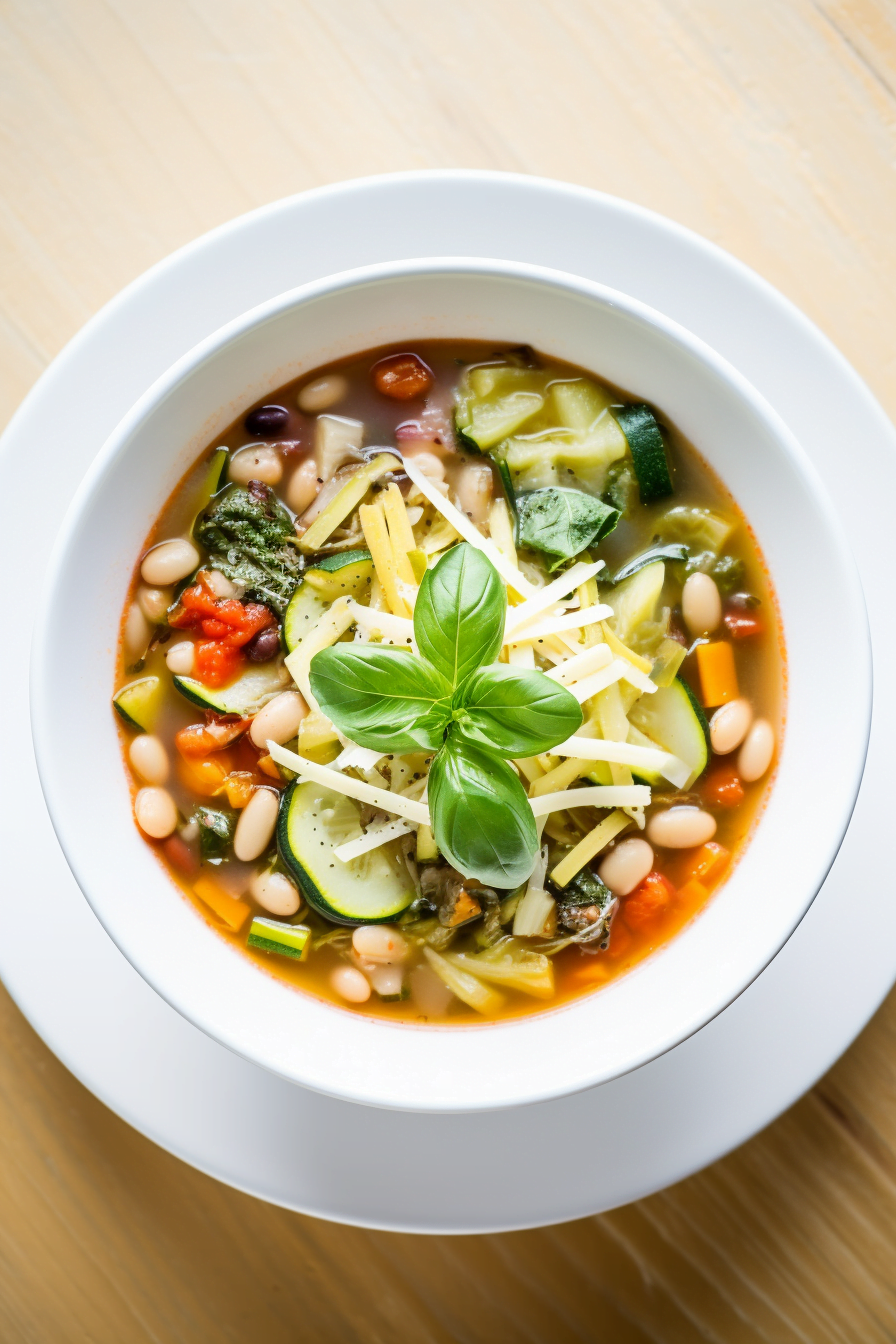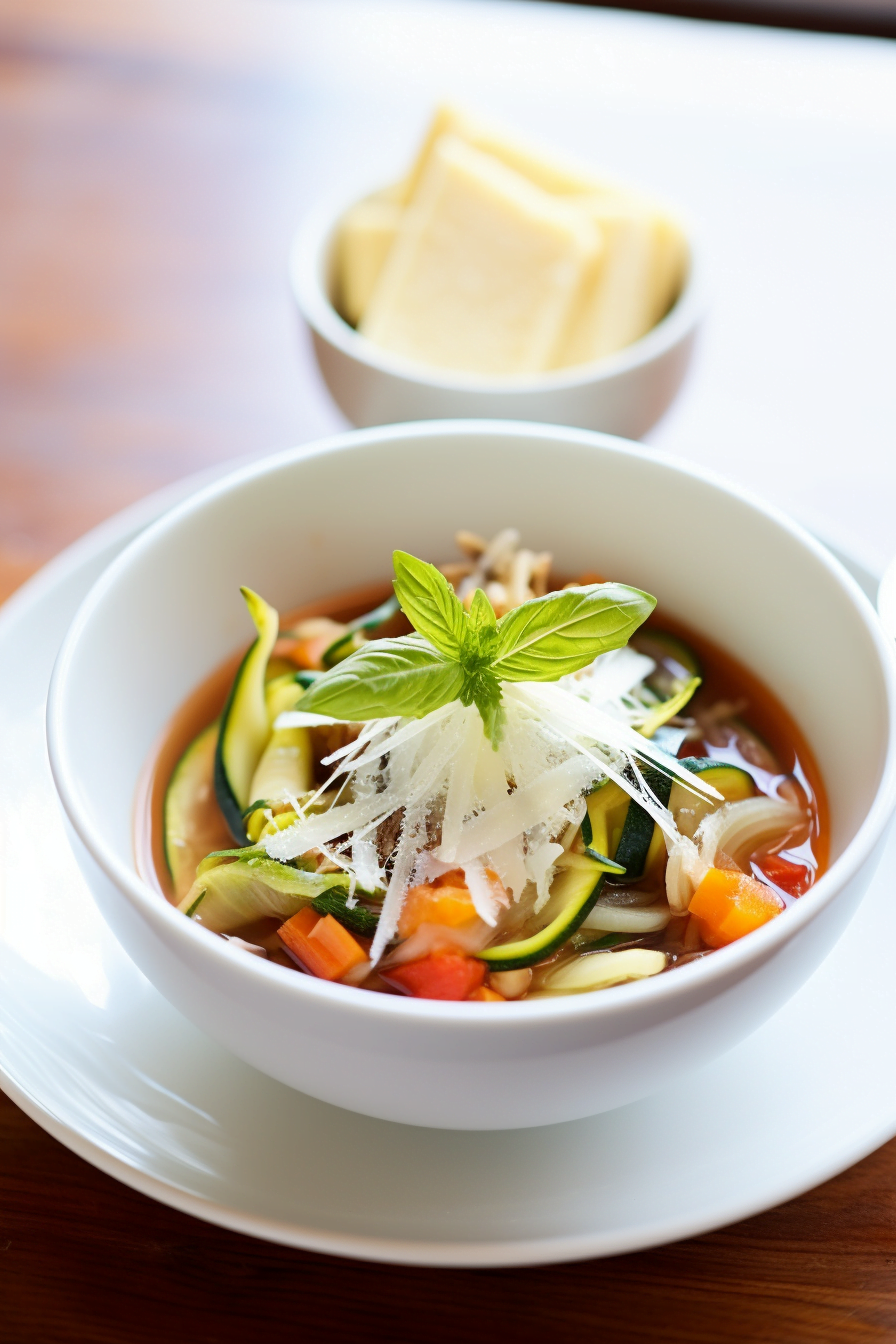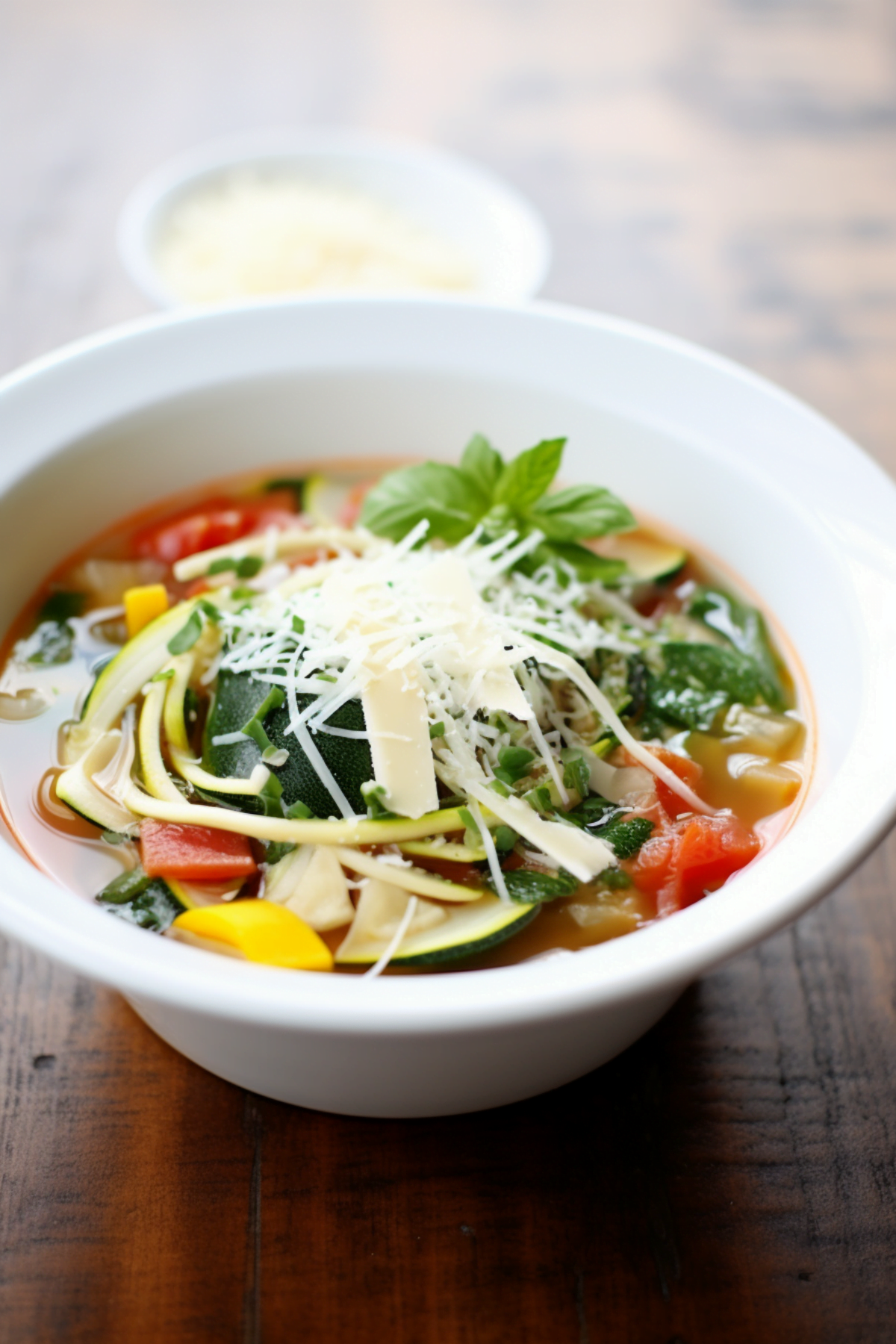Neapolitan Zucchini and Basil Minestrone: A Taste of Naples
Imagine a bowl of warm, comforting soup that not only nourishes your body but also transports you to the sun-drenched coast of Naples. That’s exactly what you get with our Neapolitan Zucchini and Basil Minestrone. This recipe is a celebration of fresh vegetables, aromatic herbs, and the simplicity of Mediterranean cooking. Perfect for any season, it’s a dish that promises to be both hearty and healthy.
As you continue reading, you’ll discover the rich history behind this traditional soup, as well as tips and tricks to make it just like a Neapolitan nonna would. Whether you’re a seasoned chef or a home cook, this minestrone is sure to become a staple in your culinary repertoire.

Origins and Inspiration Behind the Recipe
The Neapolitan Zucchini and Basil Minestrone is a dish steeped in history, with roots deeply embedded in the heart of Southern Italy’s Campania region. This soup is a testament to the Neapolitan philosophy of cucina povera, which translates to “poor kitchen,” a concept that revolves around making the most out of a few simple and fresh ingredients.
Inspired by the bountiful produce found in the local markets of Naples, this minestrone is a reflection of the region’s agricultural richness. The use of zucchini and basil is particularly significant, as these ingredients are staples in Neapolitan cuisine and thrive in the Mediterranean climate. The soup’s vibrant flavors are a result of the fertile volcanic soil, courtesy of Mount Vesuvius, which imparts a unique taste to the region’s produce.
Traditionally, this minestrone would be prepared with whatever vegetables were on hand, making it a versatile dish that changed with the seasons. It’s a perfect example of how Neapolitan cooking respects the natural cycle of ingredients, ensuring that each bowl is a true representation of the season’s best.
The addition of pasta to the soup is a nod to Italy’s love affair with pasta in all its forms. In this recipe, small pasta shapes are used to add texture and heartiness, making the minestrone a filling meal on its own. The finishing touch of fresh basil brings a burst of flavor and a fragrant aroma that is quintessentially Italian.
As you prepare this minestrone, you’ll be embracing a piece of Neapolitan culture, where food is not just sustenance but a celebration of life’s simple pleasures.

Mastering the Method
The key to a perfect Neapolitan Zucchini and Basil Minestrone lies in the method. Begin by heating the olive oil in a large pot. The choice of olive oil is crucial, as it imparts a distinct flavor to the dish. Use a high-quality extra virgin olive oil for the best results.
Once the oil is shimmering, add the diced onion. Sautéing the onion until it’s translucent is essential, as it forms the flavor base of the soup. Be careful not to brown the onions, as this can alter the taste of the minestrone.
Next, the addition of minced garlic is timed to ensure it doesn’t burn but becomes fragrant enough to infuse the soup with its aroma. After the garlic, the diced vegetables are added. It’s important to cut the zucchini, carrot, and celery uniformly to ensure even cooking.
When adding the diced tomatoes, vegetable broth, and water, make sure to scrape any browned bits off the bottom of the pot. This is called deglazing, and it ensures that all the flavors are incorporated into the broth.
Seasoning with salt, black pepper, dried oregano, and a bay leaf introduces layers of flavor. Allow the soup to simmer gently; this slow cooking process melds the flavors together and brings out the natural sweetness of the vegetables.
The pasta should be cooked until al dente, which means it’s tender but still has a slight bite to it. This texture contrasts beautifully with the soft vegetables and prevents the pasta from becoming too mushy.
Finally, stirring in the fresh basil at the end preserves its vibrant color and delicate flavor. Basil is a heat-sensitive herb, and adding it too early can cause it to lose its essence.
Remember, the beauty of this minestrone is in its simplicity. Each ingredient should shine, and the cooking process should respect the integrity of those ingredients. With these tips in mind, you’re well on your way to creating a truly authentic Neapolitan Zucchini and Basil Minestrone.

Variations to the Classic Minestrone
Seafood Minestrone
For a coastal twist, add fresh seafood to your minestrone. Mussels, clams, and prawns are excellent choices that complement the flavors of the soup. Add the seafood towards the end of the cooking process to ensure it’s tender and not overcooked.
Winter Vegetable Minestrone
In the colder months, substitute zucchini with winter squash, like butternut or pumpkin. Kale or Swiss chard can also be added for extra heartiness. These ingredients will give the soup a comforting depth suitable for chilly weather.
Legume-Enriched Minestrone
Boost the protein content by adding legumes such as cannellini beans or chickpeas. This variation is particularly filling and adds a creamy texture to the minestrone.
Ingredient Substitutions
While the classic recipe is a staple, there may be times when you need to make substitutions. Here are a few to consider:
Gluten-Free Pasta
If you’re catering to a gluten-free diet, replace the traditional pasta with a gluten-free alternative. Rice or quinoa pasta are great options that maintain the texture of the dish without compromising flavor.
Vegetable Broth Alternatives
Chicken or beef broth can be used in place of vegetable broth for a richer taste. Keep in mind that this will change the dish from vegetarian to non-vegetarian.
Dairy-Free Cheese
For those who are lactose intolerant or vegan, nutritional yeast or a dairy-free cheese alternative can be used in place of Parmesan to add a cheesy flavor.
Frequently Asked Questions
| Question | Answer |
|---|---|
| Can this soup be made ahead of time? | Yes, the flavors actually improve overnight. Just reheat gently before serving. |
| How can I thicken the minestrone if it’s too watery? | Simmer it uncovered to reduce the liquid, or add a small amount of tomato paste to thicken. |
| What can I use if I don’t have fresh basil? | Dried basil can be used in a pinch, but add it earlier in the cooking process to allow its flavor to develop. |
| Is this minestrone suitable for freezing? | Yes, it freezes well. Just omit the pasta and add it fresh when reheating to avoid sogginess. |
| Can I make this recipe in a slow cooker? | Absolutely, just add all ingredients except the pasta and basil, cook on low for 6-8 hours, then add pasta and basil at the end. |

Neapolitan Zucchini and Basil Minestrone
Equipment
- Large pot
- Cutting board
- Chef's knife
- Wooden spoon
- Measuring cups and spoons
Ingredients
- 2 tbsp extra virgin olive oil 30ml
- 1 medium onion, diced 150g
- 2 cloves garlic, minced 10g
- 2 medium zucchinis, diced about 500g
- 1 large carrot, peeled and diced about 150g
- 1 stalk celery, diced about 64g
- 1 can diced tomatoes 14.5 ounces or 411g
- 4 cups vegetable broth 960ml
- 1 cup water 240ml
- 1 tsp salt 5g
- 1/2 tsp freshly ground black pepper 1g
- 1 tsp dried oregano 1g
- 1 bay leaf
- 1 cup small pasta shapes 100g
- 1 cup fresh basil leaves, chopped about 40g
- Grated Parmesan cheese, for serving optional
- 1/2 cup fresh parsley, chopped for garnish
Instructions
- Heat the olive oil in a large pot over medium heat. Add the diced onion and sauté until translucent, about 5 minutes.
- Stir in the minced garlic and cook for an additional minute until fragrant.
- Add the diced zucchinis, carrot, and celery to the pot. Cook, stirring occasionally, for about 5 minutes, or until the vegetables start to soften.
- Pour in the can of diced tomatoes (with juices), vegetable broth, and water. Stir in the salt, black pepper, dried oregano, and bay leaf. Bring the mixture to a boil.
- Once boiling, reduce the heat to a simmer and let cook for 15 minutes, allowing the flavors to meld together.
- Add the small pasta shapes to the pot and continue to simmer until the pasta is cooked al dente, about 10 minutes.
- Remove the bay leaf and adjust seasoning if necessary. Stir in the fresh basil leaves just before serving.
- Ladle the minestrone into bowls and, if desired, top with grated Parmesan cheese and a sprinkle of chopped parsley.
Notes

